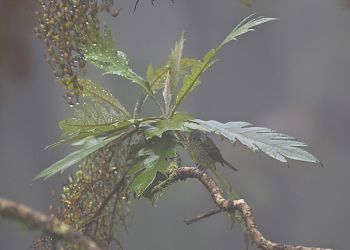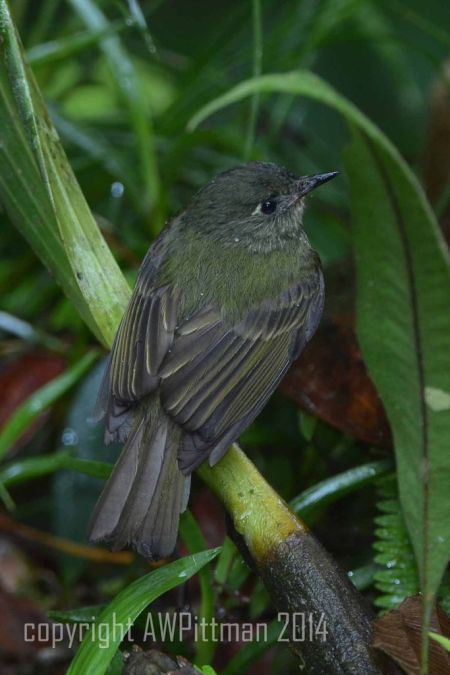- Mionectes galbinus
Identification
13-13.5 cm. Olive-greenish bird with triangular white mark behind eye and streaked breast.
- Upperside olive-green
- Wings darker but with yellowish to ochre edges
- Behind eye is a triangular white spot
- Side of head, throat and upper breast streaked with dark olive-green and yellowish-whitish
- Flanks and lower breast has continued streaks with clearer yellow in between
- Belly is yellow with minimal streaking
Male and female similar.
Similar Species
Olive-streaked Flycatcher should not overlap in range. It is very difficult to distinguish except by voice. Streak-necked Flycatcher overlaps in much of the Andean areas. It differs in most locations by having grey crown and sides of head, as well as yellower belly with less streaking. Overalp is problematic in western Ecuador and Colombia where they are less different but do show white shaft streaks in head and throat and still has less streaking on belly.
Distribution
Central and South America: eastern half of Panama,Colombia, Venezuela, Trinidad, Ecuador, Peru and Bolivia.

Photo © by Stanley Jones
Altos del Maria east of El Valle de Anton, Panama Province, Panama, 5 March 2013
Taxonomy
Olive-streaked Flycatcher was formerly considered the nominate subspecies under this species, which back then therefore had the scientific name of Mionectes olivaceus.
Subspecies
Four subspecies are recognized[1].
- M. g. hederaceus:
- M. g. galbinus:
- Santa Marta Mountains (north-eastern Colombia)
- M. g. venezuelensis:
- M. g. fasciaticollis:
Two additional subspecies pallidus and meridae are generally considered invalid[3].
Habitat
Moist lowland forests and montanes.
Behaviour
Eats fruit and also consumes invertebrates. Both are taken while hovering, or less commonly while supported by plant material.
Vocalisation
Song: only given during breeding´period. Several vocal groups (geographically separated) may warrant further study. They all have in common that the song is locally very stereotypical and very high pitched, and that it lasts from 10 seconds to a lot longer. In some areas described as insect- or hummingbird-like.
Call described as a clear, descending sound which is also very high pitched.
References
- Clements, J. F., T. S. Schulenberg, M. J. Iliff, T. A. Fredericks, J. A. Gerbracht, D. Lepage, S. M. Billerman, B. L. Sullivan, and C. L. Wood. 2022. The eBird/Clements checklist of Birds of the World: v2022. Downloaded from https://www.birds.cornell.edu/clementschecklist/download/
- Gill, F, D Donsker, and P Rasmussen (Eds). 2023. IOC World Bird List (v 13.1)_red. Doi 10.14344/IOC.ML.13.1. http://www.worldbirdnames.org/
- Avibase
- Sainz-Borgo, C., H. F. Greeney, and A. J. Spencer (2022). Olive-striped Flycatcher (Mionectes galbinus), version 3.0. In Birds of the World (T. S. Schulenberg and B. K. Keeney, Editors). Cornell Lab of Ornithology, Ithaca, NY, USA. https://doi.org/10.2173/bow.olsfly1.03
Recommended Citation
- BirdForum Opus contributors. (2024) Olive-striped Flycatcher. In: BirdForum, the forum for wild birds and birding. Retrieved 26 April 2024 from https://www.birdforum.net/opus/Olive-striped_Flycatcher
External Links
GSearch checked for 2020 platform.1




